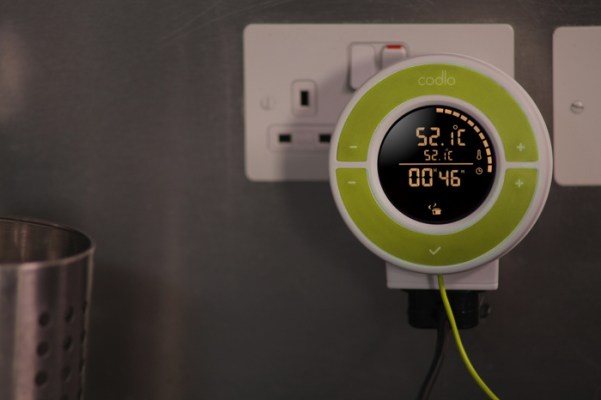Another home sous vide machine is about to enter the market. UK-made Codlo just passed its Kickstarter goal, with only five days to spare.
Sous vide is a French method of cooking food sealed in airtight bags in a water bath. The idea is to immerse them in a regulated temperature that isn’t as hot as boiling water, with the intention of cooking them evenly throughout. The original Sous Vide Supreme machine starts at $429, and the professional model costs $749—and that’s before you add in all the vacuum bags and so on.
The sous vide trend has been gaining more awareness among home cooks in recent years, and Codlo is part of a trend of new budget-friendly cooking devices meant to offer the technology at home. Last year, the Nomiku device was successfully kickstarted, at more than twice its goal of $200,000.
The Codlo’s goal was a slightly lower $153,580 (£100,000). Both devices attach to existing vessels such as pots and rice cookers to turn them into sous vide machines. Codlo’s co-founder, Grace Lee, said that the funding will give the 12-man team just enough to invest in safety certification and the injection molding process.
“Manufacturing is hard. These days, with cheap reliable hardware coming out, it’s easy to overlook how complex hardware manufacturing is,” she said. Making precision devices like sous vide attachments can be more expensive to construct because they need to be rugged for the kitchen while staying sensitive to temperature fluctuations.
“It can be challenging to aim for temperature stability within fractions of a degree, that’s needed for sensitive food such as fish and eggs,” she said.
The Codlo’s individual components such as the circuitry, screen and power supply will be made in China. The device will be assembled in the UK “to limit intellectual property issues”, she said.
The Nomiku team, on the other hand, decided to make a much bigger investment in the device’s manufacturing process. Two of its three co-founders, Abe Fetterman and Bam Suppipat, relocated from San Francisco to Hong Kong and have been living there for the past six months, to oversee manufacturing across the water in Shenzhen.
Fetterman said: “Being on the ground has helped us communicate more effectively and resolve problems quickly. Our biggest issues have been communication and cultural differences. A project like this involves a lot of people, and they all need to be synchronized.”
Perhaps reflecting Lee’s point on the complexities of manufacturing these devices, mass producing the Nomiku has taken the better part of the past year since its campaign ended in July 2012. The team is expecting to launch the devices end of this month in the fall, it just told backers. Its initial projection was for February for the US and March for international customers. I was fortunate enough to sample a rack of ribs prepared with a Nomiku prototype when I visited Hong Kong in March this year, but it seems mass production has been a hard nut to crack.
For now, both teams don’t seem too worried about any impending competition on the home sous vide front. Fetterman acknowledged that there’s nothing to stop a big manufacturer from coming in and making a cheaper sous vide, at scale. “But sous vide cooking is still not well known, so bigger corporations entering the space will only increase the demand for these appliances,” he said.
Lee pointed out that the barriers to entry for smaller makers should keep the market from being flooded with Nomikus and Codlos. “Sous vide today is a much smaller market compared to, say, mixers, blenders, ovens, cookers. Temperature control is challenging, and existing sous vide appliances tend to be offshoots from temperature control specialists rather than kitchen manufacturers,” she said.
